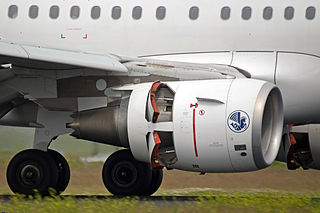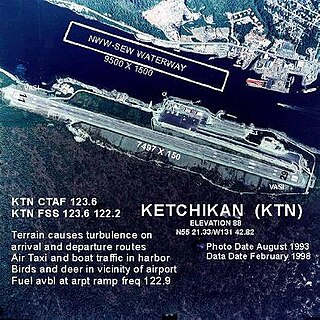
Flash Airlines Flight 604 was a charter flight from Sharm El Sheikh International Airport in Egypt to Charles de Gaulle International Airport in Paris, France, with a stop-over at Cairo International Airport, provided by Egyptian private charter company Flash Airlines. On 3 January 2004, the Boeing 737-300 that was operating the route crashed into the Red Sea shortly after takeoff from Sharm El Sheikh International Airport, killing all 135 passengers, most of whom were French tourists, and all thirteen crew members. The findings of the crash investigation were controversial, with accident investigators from the different countries involved unable to agree on the cause of the accident.

Thrust reversal, also called reverse thrust, is the temporary diversion of an aircraft engine's thrust for it to act against the forward travel of the aircraft, providing deceleration. Thrust reverser systems are featured on many jet aircraft to help slow down just after touch-down, reducing wear on the brakes and enabling shorter landing distances. Such devices affect the aircraft significantly and are considered important for safe operations by airlines. There have been accidents involving thrust reversal systems, including fatal ones.

United Airlines Flight 585 was a scheduled passenger flight on March 3, 1991, from Denver to Colorado Springs, Colorado, carrying 20 passengers and 5 crew members on board. The plane experienced a rudder hardover while on final approach to runway 35 at Colorado Springs Municipal Airport, causing the plane to roll over and enter an uncontrolled dive. All 25 people on board the 737 were killed on impact.

Cranbrook/Canadian Rockies International Airport is an international airport located 5 nautical miles north of Cranbrook and 20 km (12 mi) south-east of Kimberley, British Columbia, in the Canadian Rockies.

Ketchikan International Airport is a state-owned, public-use airport located one nautical mile (2 km) west of the central business district of Ketchikan, a city in Ketchikan Gateway Borough in Alaska, that has no direct road access to the outside world or to the airport. The airport is located on Gravina Island, just west of Ketchikan on the other side of the Tongass Narrows. Passengers must take a seven-minute ferry ride across the water to get to the airport from the town.

Qantas 1 was a Qantas passenger flight between Sydney and London that was involved in a runway overrun accident at Don Mueang International Airport in Bangkok on 23 September 1999 as it was landing for a stopover.

Southwest Airlines Flight 1248 was a scheduled passenger flight from Baltimore, Maryland, to Chicago, Illinois, continuing on to Salt Lake City, Utah, and then to Las Vegas, Nevada. On December 8, 2005, the airplane slid off a runway at Chicago-Midway while landing in a snowstorm and crashed into automobile traffic, killing a six-year-old boy.

Southwest Airlines Flight 1455 was a scheduled passenger flight from McCarran International Airport, Las Vegas, Nevada, to Burbank-Glendale-Pasadena Airport, Burbank, California, that overran the runway during landing on March 5, 2000. The aircraft, a Boeing 737-3T5, registration N668SW, came to rest on a city street adjacent to a gas station. The National Transportation Safety Board found that the incident was due to the pilots attempting to land with excessive speed. They also found that the air traffic controller placed them in a position from which their only option was a go around. Two of the passengers were seriously injured, and there were many minor injuries. As a result of the incident, the airport installed an Engineered Materials Arrestor System at the east end of the incident runway. The aircraft was written off, making the incident the 10th hull loss of a Boeing 737-300. This was the first major accident in the airline's 29-year history.

Garuda Indonesia Flight 200(GA200/GIA 200) was a scheduled domestic passenger flight of a Boeing 737-400 operated by Garuda Indonesia between Jakarta and Yogyakarta, Indonesia. The aircraft overran the runway, crashed into a rice field and burst into flames while landing at Adisucipto International Airport on 7 March 2007. Twenty passengers and one flight attendant were killed. Both pilots survived, and were fired shortly after the accident occurred. It was the fifth hull-loss of a Boeing 737 in Indonesia within less than six months and was the most recent accident with fatalities involving the airline.

Indian Airlines Flight 491 (IC491/IAC491) was a scheduled domestic passenger flight from Aurangabad to Bombay, operated by India's national airline Indian Airlines. On 26 April 1993, the aircraft operating the flight, a Boeing 737-2A8 with a registration of VT-ECQ crashed shortly after take-off following the aircraft's impact with a lorry and a high tension power line. The crash killed 55 people and injured 63 others.

Alliance Air Flight 7412 was a scheduled Indian domestic passenger flight from Calcutta to Delhi, operated by Indian regional airliner Alliance Air. On 17 July 2000, while on approach to its first stopover in Patna, the Boeing 737-2A8 operating the route nose-dived and crashed into a residential area in Patna, killing 60 people including 5 on the ground.

China Airlines Flight 605 was a daily non-stop flight departing from Taipei at 6:30 a.m. and arriving at Kai Tak Airport in Hong Kong at 7:00 a.m. local time. On November 4, 1993, the plane went off the runway and overran while landing during a storm. It was the first hull loss of a Boeing 747-400.

Turkish Airlines Flight 1951 was a passenger flight that crashed during landing at Amsterdam Schiphol Airport, the Netherlands, on 25 February 2009, resulting in the deaths of nine passengers and crew, including all three pilots.

Southwest Air Lines Flight 611 was a scheduled flight from Naha to Ishigaki. On 26 August 1982, the Boeing 737-200 overran the runway while attempting to land. The aircraft caught fire and was destroyed, but none of the 133 passengers and 5 crew died in the accident although two crew and one passenger were seriously injured.
In aeronautics, loss of control (LOC) is the unintended departure of an aircraft from controlled flight and is a significant factor in several aviation accidents worldwide. In 2015 it was the leading cause of general aviation accidents. Loss of control may be the result of mechanical failure, external disturbances, aircraft upset conditions, or inappropriate crew actions or responses.

Bhoja Air Flight 213 was a domestic scheduled passenger flight operated by Pakistani airline Bhoja Air from Karachi to Islamabad. On 20 April 2012, the Boeing 737-236A aircraft serving the route crashed in bad weather during its final approach to land. All 121 passengers and 6 crew members aboard were killed. With 127 deaths, it remains as the second deadliest air disaster in Pakistan.

Tatarstan Airlines Flight 363 was a scheduled domestic passenger flight, operated by Tatarstan Airlines on behalf of Ak Bars Aero, from Moscow to Kazan, Russia. On 17 November 2013, at 19:24 local time (UTC+4), the Boeing 737-500 crashed during an aborted landing at Kazan International Airport, killing all 44 passengers and 6 crew members on board, making it 2013's worst plane crash.

Miami Air International Flight 293 was a military charter from Guantanamo Bay to Naval Air Station Jacksonville, operated by Miami Air International. On May 3, 2019, the Boeing 737-800 aircraft operating the flight overran the runway on landing. Twenty-one people were injured. The aircraft was written off, making it the 17th loss of a Boeing 737-800. The National Transportation Safety Board (NTSB) attributed the accident to hydroplaning caused by heavy rainfall on the ungrooved runway; although the pilots were found to have made a series of errors during final approach and landing, the NTSB concluded that these errors had little effect on the final outcome, as the aircraft would have been unable to stop even if the landing had been executed properly.

Japan Air Lines Cargo Flight 46E was a scheduled cargo flight on 31 March 1993, operated by Evergreen International Airlines, on behalf of Japan Air Lines, from Anchorage International Airport, in Anchorage, Alaska, to O'Hare International Airport, in Chicago. After departure, while climbing through 2,000 feet, the pylon for engine two detached, causing the whole engine to fall off the wing. The pilots managed to land the 747 back at Anchorage without further incident.


















